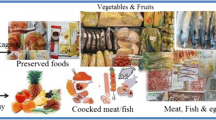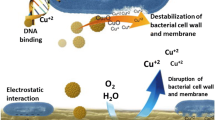Abstract
Zinc oxide (ZnO) is an inorganic compound widely used in everyday applications. ZnO is currently listed as a generally recognized as safe (GRAS) material by the Food and Drug Administration and is used as food additive. The advent of nanotechnology has led the development of materials with new properties for use as antimicrobial agents. Thus, ZnO in nanoscale has shown antimicrobial properties and potential applications in food preservation. ZnO nanoparticles have been incorporated in polymeric matrices in order to provide antimicrobial activity to the packaging material and improve packaging properties. This review presents the main synthesis methods of ZnO nanoparticles, principal characteristics and mechanisms of antimicrobial action as well as the effect of their incorporation in polymeric matrices. Safety issues such as exposure routes and migration studies are also discussed.






Similar content being viewed by others
References
Adams, L. K., Lyon, D. Y., & Alvarez, P. J. J. (2006). Comparative eco-toxicity of nanoscale TiO2, SiO2, and ZnO water suspensions. Water Research, 40(19), 3527–3532.
Aghababazadeh, R., Mazinani, B., Mirhabibi, A., & Tamizifar, M. (2006). ZnO nanoparticles synthesised by mechanochemical processing. Journal of Physics Conference Series, 26(1), 312.
Ahvenainen, R. (Ed.). (2003). Novel food packaging techniques. Cambridge, UK: Woodhead Publishing Limited.
Ajayan, P. M., Schadler, L. S., & Braun, P. V. (Eds.). (2003). Nanocomposite science and technology. Weinheim: Wiley-VCH.
Alvarez-Peral, F. J., Zaragoza, O., Pedreno, Y., & Argüelles, J.-C. (2002). Protective role of trehalose during severe oxidative stress caused by hydrogen peroxide and the adaptive oxidative stress response in Candida albicans. Microbiology, 148(8), 2599–2606.
Ao, W., Li, J., Yang, H., Zeng, X., & Ma, X. (2006). Mechanochemical synthesis of zinc oxide nanocrystalline. Powder Technology, 168(3), 148–151.
Appendini, P., & Hotchkiss, J. H. (1997). Immobilization of lysozyme on food contact polymers as potential antimicrobial films. Packaging Technology and Science, 10(5), 271–279.
Applerot, G., Lipovsky, A., Dror, R., Perkas, N., Nitzan, Y., Lubart, R., & Gedanken, A. (2009). Enhanced antibacterial activity of nanocrystalline ZnO due to increased ROS-mediated cell injury. Advanced Functional Materials, 19(6), 842–852.
Applerot, G., Perkas, N., Amirian, G., Girshevitz, O., & Gedanken, A. (2009). Coating of glass with ZnO via ultrasonic irradiation and a study of its antibacterial properties. Applied Surface Science, 256(3), S3–S8.
Arora, A., & Padua, G. W. (2010). Review: nanocomposites in food packaging. Journal of Food Science, 75(1), R43–R49.
Bhadra, P., Mitra, M. K., Das, G. C., Dey, R., & Mukherjee, S. (2011). Interaction of chitosan capped ZnO nanorods with Escherichia coli. Materials Science and Engineering: C, 31(5), 929–937.
Bradley EL, Castle L & Chaudhry Q (2011) Applications of nanomaterials in food packaging with a consideration of opportunities for developing countries. Trends in Food Science & Technology, In Press, Accepted Manuscript, doi: 10.1016/j.tifs.2011.01.002
Brayner, R., Ferrari-Iliou, R., Brivois, N., Djediat, S., Benedetti, M. F., & Fiévet, F. (2006). Toxicological impact studies based on Escherichia coli bacteria in ultrafine ZnO nanoparticles colloidal medium. Nano Letters, 6(4), 866–870.
Casey, P. (2006). Nanoparticle technologies and applications. In R. H. J. Hannink & A. J. Hill (Eds.), Nanostructure control of materials (pp. 1–27). Cambridge, UK: Woodhead Publishing Limited.
CDC (2011) 2011 Estimates of foodborne illness in the United States. Center for Disease Control and Prevention, Atlanta, USA. Available at: http://www.cdc.gov/Features/dsFoodborneEstimates/. Accessed 6 May 2011.
Chaudhry, Q., Scotter, M., Blackburn, J., Ross, B., Boxall, A., Castle, L., Aitken, R., & Watkins, R. (2008). Applications and implications of nanotechnologies for the food sector. Food Additives & Contaminants: Part A, 25(3), 241–258.
Cho, J. W., & Paul, D. R. (2001). Nylon 6 nanocomposites by melt compounding. Polymer, 42(3), 1083–1094.
Cioffi, N., Torsi, L., Ditaranto, N., Tantillo, G., Ghibelli, L., Sabbatini, L., Bleve-Zacheo, T., D'Alessio, M., Zambonin, P. G., & Traversa, E. (2005). Copper nanoparticle/polymer composites with antifungal and bacteriostatic properties. Chemistry of Materials, 17(21), 5255–5262.
De Berardis, B., Civitelli, G., Condello, M., Lista, P., Pozzi, R., Arancia, G., & Meschini, S. (2010). Exposure to ZnO nanoparticles induces oxidative stress and cytotoxicity in human colon carcinoma cells. Toxicology and Applied Pharmacology, 246(3), 116–127.
Devirgiliis, C., Murgia, C., Danscher, G., & Perozzi, G. (2004). Exchangeable zinc ions transiently accumulate in a vesicular compartment in the yeast Saccharomyces cerevisiae. Biochemical and Biophysical Research Communications, 323(1), 58–64.
Emamifar, A., Kadivar, M., Shahedi, M., & Soleimanian-Zad, S. (2010). Evaluation of nanocomposite packaging containing Ag and ZnO on shelf life of fresh orange juice. Innovative Food Science & Emerging Technologies, 11(4), 742–748.
Emamifar, A., Kadivar, M., Shahedi, M., & Soleimanian-Zad, S. (2011). Effect of nanocomposite packaging containing Ag and ZnO on inactivation of Lactobacillus plantarum in orange juice. Food Control, 22(3–4), 408–413.
Epand, R. M., & Epand, R. F. (2009). Lipid domains in bacterial membranes and the action of antimicrobial agents. Biochimica et Biophysica Acta (BBA)—Biomembranes, 1788(1), 289–294.
Eskandari, M., Haghighi, N., Ahmadi, V., Haghighi, F., & Mohammadi, S. R. (2011). Growth and investigation of antifungal properties of ZnO nanorod arrays on the glass. Physica B: Condensed Matter, 406(1), 112–114.
FDA (2011) Part 182—substances generally recognized as safe. Food and drug administration, Washington DC, USA. Available at: http://ecfr.gpoaccess.gov/cgi/t/text/text-idx?c=ecfr&sid=786bafc6f6343634fbf79fcdca7061e1&rgn=div5&view=text&node=21:3.0.1.1.13&idno=21#21:3.0.1.1.13.9. Accessed 28 March 2011.
Gálvez, A., Abriouel, H., López, R. L., & Omar, N. B. (2007). Bacteriocin-based strategies for food biopreservation. International Journal of Food Microbiology, 120(1–2), 51–70.
Ghule, K., Ghule, A. V., Chen, B.-J., & Ling, Y.-C. (2006). Preparation and characterization of ZnO nanoparticles coated paper and its antibacterial activity study. Green Chemistry, 8(12), 1034–1041.
Gordon, T., Perlstein, B., Houbara, O., Felner, I., Banin, E., & Margel, S. (2011). Synthesis and characterization of zinc/iron oxide composite nanoparticles and their antibacterial properties. Colloids and Surfaces A: Physicochemical and Engineering Aspects, 374(1–3), 1–8.
Guo, D., Wu, C., Jiang, H., Li, Q., Wang, X., & Chen, B. (2008). Synergistic cytotoxic effect of different sized ZnO nanoparticles and daunorubicin against leukemia cancer cells under UV irradiation. Journal of Photochemistry and Photobiology B: Biology, 93(3), 119–126.
Han, J. H. (2005). Antimicrobial packaging systems. In H. H. Jung (Ed.), Innovations in food packaging (pp. 80–107). London: Academic Press.
He, L., Liu, Y., Mustapha, A., & Lin, M. (2011). Antifungal activity of zinc oxide nanoparticles against Botrytis cinerea and Penicillium expansum. Microbiological Research, 166(3), 207–215.
Heng, B. C., Zhao, X., Xiong, S., Woei Ng, K., Yin-Chiang Boey, F., & Say-Chye Loo, J. (2010). Toxicity of zinc oxide (ZnO) nanoparticles on human bronchial epithelial cells (BEAS-2B) is accentuated by oxidative stress. Food and Chemical Toxicology, 48(6), 1762–1766.
Hirota, K., Sugimoto, M., Kato, M., Tsukagoshi, K., Tanigawa, T., & Sugimoto, H. (2010). Preparation of zinc oxide ceramics with a sustainable antibacterial activity under dark conditions. Ceramics International, 36(2), 497–506.
Hoskin, D. W., & Ramamoorthy, A. (2008). Studies on anticancer activities of antimicrobial peptides. Biochimica et Biophysica Acta: Biomembranes, 1778(2), 357–375.
Hsiao, I. L., & Huang, Y.-J. (2011). Effects of various physicochemical characteristics on the toxicities of ZnO and TiO2 nanoparticles toward human lung epithelial cells. Science of the Total Environment, 409(7), 1219–1228.
Huang, C.-C., Aronstam, R. S., Chen, D.-R., & Huang, Y.-W. (2010). Oxidative stress, calcium homeostasis, and altered gene expression in human lung epithelial cells exposed to ZnO nanoparticles. Toxicology In Vitro, 24(1), 45–55.
Hütter, G., & Sinha, P. (2001). Proteomics for studying cancer cells and the development of chemoresistance. Proteomics, 1(10), 1233–1248.
Jalal, R., Goharshadi, E. K., Abareshi, M., Moosavi, M., Yousefi, A., & Nancarrow, P. (2010). ZnO nanofluids: green synthesis, characterization, and antibacterial activity. Materials Chemistry and Physics, 121(1–2), 198–201.
Jiang, W., Saxena, A., Song, B., Ward, B. B., Beveridge, T. J., & Myneni, S. C. B. (2004). Elucidation of functional groups on Gram-positive and Gram-negative bacterial surfaces using infrared spectroscopy. Langmuir, 20(26), 11433–11442.
Jin, T., & Gurtler, J. B. (2011). Inactivation of Salmonella in liquid egg albumen by antimicrobial bottle coatings infused with allyl isothiocyanate, nisin and zinc oxide nanoparticles. Journal of Applied Microbiology, 110(3), 704–712.
Jin, T., Sun, D., Su, J. Y., Zhang, H., & Sue, H. J. (2009). Antimicrobial efficacy of zinc oxide quantum dots against Listeria monocytogenes, Salmonella enteritidis, and Escherichia coli O157:H7. Journal of Food Science, 74(1), M46–M52.
Jones, N., Ray, B., Ranjit, K. T., & Manna, A. C. (2008). Antibacterial activity of ZnO nanoparticle suspensions on a broad spectrum of microorganisms. FEMS Microbiology Letters, 279(1), 71–76.
Juzenas, P., Chen, W., Sun, Y.-P., Coelho, M. A. N., Generalov, R., Generalova, N., & Christensen, I. L. (2008). Quantum dots and nanoparticles for photodynamic and radiation therapies of cancer. Advanced Drug Delivery Reviews, 60(15), 1600–1614.
Kasemets, K., Ivask, A., Dubourguier, H.-C., & Kahru, A. (2009). Toxicity of nanoparticles of ZnO, CuO and TiO2 to yeast Saccharomyces cerevisiae. Toxicology In Vitro, 23(6), 1116–1122.
Koo, J. (2006). Polymer nanocomposites: Processing, characterization, and application. New York, USA: McGraw-Hill.
Kulkarni, S. B., Patil, U. M., Salunkhe, R. R., Joshi, S. S., & Lokhande, C. D. (2011). Temperature impact on morphological evolution of ZnO and its consequent effect on physico-chemical properties. Journal of Alloys and Compounds, 509(8), 3486–3492.
Lepot, N., Van Bael, M.K., Van den Rul, H., D'Haen, J., Peeters, R., Franco, D., & Mullens, J. (2007). Synthesis of ZnO nanorods from aqueous solution. Materials Letters, 61(13), 2624–2627.
Lepot, N., Van Bael, M. K., Van den Rul, H., D'Haen, J., Peeters, R., Franco, D., & Mullens, J. (2011). Influence of incorporation of ZnO nanoparticles and biaxial orientation on mechanical and oxygen barrier properties of polypropylene films for food packaging applications. Journal of Applied Polymer Science, 120(3), 1616–1623.
Li, J. H., Hong, R. Y., Li, M. Y., Li, H. Z., Zheng, Y., & Ding, J. (2009). Effects of ZnO nanoparticles on the mechanical and antibacterial properties of polyurethane coatings. Progress in Organic Coatings, 64(4), 504–509.
Lu, J., Ng, K. M., & Yang, S. (2008). Efficient, one-step mechanochemical process for the synthesis of ZnO nanoparticles. Industrial and Engineering Chemistry Research, 47(4), 1095–1101.
Nair, S., Sasidharan, A., Divya Rani, V., Menon, D., Nair, S., Manzoor, K., & Raina, S. (2009). Role of size scale of ZnO nanoparticles and microparticles on toxicity toward bacteria and osteoblast cancer cells. Journal of Materials Science. Materials in Medicine, 20, 235–241.
Nohynek, G. J., Antignac, E., Re, T., & Toutain, H. (2010). Safety assessment of personal care products/cosmetics and their ingredients. Toxicology and Applied Pharmacology, 243(2), 239–259.
Oberdörster, G., Maynard, A., Donaldson, K., Castranova, V., Fitzpatrick, J., Ausman, K., Carter, J., Karn, B., Kreyling, W., Lai, D., Olin, S., Monteiro-Riviere, N., Warheit, D., & Yang, H. (2005). Principles for characterizing the potential human health effects from exposure to nanomaterials: elements of a screening strategy. Particle and Fibre Toxicology, 2(8), 1–35.
Ohira, T., Yamamoto, O., Iida, Y., & Nakagawa, Z. (2008). Antibacterial activity of ZnO powder with crystallographic orientation. Journal of Materials Science. Materials in Medicine, 19(3), 1407–1412.
Özgür, Ü., Alivov, Y. I., Liu, C., Teke, A., Reshchikov, M. A., Doğan, S., Avrutin, V., Cho, S.-J., & Morkoç, H. (2005). A comprehensive review of ZnO materials and devices. Journal of Applied Physics, 98(4), 041301.
Padmavathy, N., & Vijayaraghavan, R. (2008). Enhanced bioactivity of ZnO nanoparticles—an antimicrobial study. Science and Technology of Advanced Materials, 9(3), 035004.
Prasad, V., Shaikh, A.J., Kathe, A.A., Bisoyi, D.K., Verma, A.K., & Vigneshwaran, N. (2010). Functional behaviour of paper coated with zinc oxide-soluble starch nanocomposites. Journal of Materials Processing Technology, 210(14), 1962–1967.
Premanathan, M., Karthikeyan, K., Jeyasubramanian, K., & Manivannan, G. (2011). Selective toxicity of ZnO nanoparticles toward Gram-positive bacteria and cancer cells by apoptosis through lipid peroxidation. Nanomedicine: Nanotechnology, Biology and Medicine, 7(2), 184–192.
Pujalté, I., Passagne, I., Brouillaud, B., Tréguer, M., Durand, E., Ohayon-Courtès, C., & L'azou, B. (2011). Cytotoxicity and oxidative stress induced by different metallic nanoparticles on human kidney cells. Particle and Fibre Toxicology, 8(10), 1–16.
Rai, M., Yadav, A., & Gade, A. (2009). Silver nanoparticles as a new generation of antimicrobials. Biotechnology Advances, 27(1), 76–83.
Reddy, K. M., Feris, K., Bell, J., Wingett, D. G., Hanley, C., & Punnoose, A. (2007). Selective toxicity of zinc oxide nanoparticles to prokaryotic and eukaryotic systems. Applied Physics Letters, 90(21), 213902.
Restuccia, D., Spizzirri, U. G., Parisi, O. I., Cirillo, G., Curcio, M., Iemma, F., Puoci, F., Vinci, G., & Picci, N. (2010). New EU regulation aspects and global market of active and intelligent packaging for food industry applications. Food Control, 21(11), 1425–1435.
Roco, M. C. (1999). Towards a US national nanotechnology initiative. Journal of Nanoparticle Research, 1(4), 435–438.
Roselli, M., Finamore, A., Garaguso, I., Britti, M. S., & Mengheri, E. (2003). Zinc oxide protects cultured enterocytes from the damage induced by Escherichia coli. Journal of Nutrition, 133(12), 4077–4082.
Russell, A. D. (2003). Similarities and differences in the responses of microorganisms to biocides. Journal of Antimicrobial Chemotherapy, 52(5), 750–763.
Sawai, J. (2003). Quantitative evaluation of antibacterial activities of metallic oxide powders (ZnO, MgO and CaO) by conductimetric assay. Journal of Microbiological Methods, 54(2), 177–182.
Sawai, J., Kojima, H., Ishizu, N., Itoh, M., Igarashi, H., Sawaki, T., & Shimizu, M. (1997). Bactericidal action of magnesium oxide powder. Journal of Inorganic Biochemistry, 67(1–4), 443–443.
Sawai, J., Shoji, S., Igarashi, H., Hashimoto, A., Kokugan, T., Shimizu, M., & Kojima, H. (1998). Hydrogen peroxide as an antibacterial factor in zinc oxide powder slurry. Journal of Fermentation and Bioengineering, 86(5), 521–522.
Schirmer, B. C., Heiberg, R., Eie, T., Møretrø, T., Maugesten, T., Carlehøg, M., & Langsrud, S. (2009). A novel packaging method with a dissolving CO2 headspace combined with organic acids prolongs the shelf life of fresh salmon. International Journal of Food Microbiology, 133(1–2), 154–160.
Schmidt-Mende, L., & MacManus-Driscoll, J. L. (2007). ZnO—nanostructures, defects, and devices. Materials Today, 10(5), 40–48.
Seven, O., Dindar, B., Aydemir, S., Metin, D., Ozinel, M. A., & Icli, S. (2004). Solar photocatalytic disinfection of a group of bacteria and fungi aqueous suspensions with TiO2, ZnO and Sahara Desert dust. Journal of Photochemistry and Photobiology A: Chemistry, 165(1–3), 103–107.
Shen, L., Bao, N., Yanagisawa, K., Domen, K., Gupta, A., & Grimes, C. A. (2006). Direct synthesis of ZnO nanoparticles by a solution-free mechanochemical reaction. Nanotechnology, 17(20), 5117.
Shi, L., Zhou, J., & Gunasekaran, S. (2008). Low temperature fabrication of ZnO—whey protein isolate nanocomposite. Materials Letters, 62(28), 4383–4385.
Silvestre, C., Duraccio, D., & Cimmino, S. (2011). Food packaging based on polymer nanomaterials. Progress in Polymer Science, 36(12), 1766–1782.
Simoncic, B., & Tomsic, B. (2010). Structures of novel antimicrobial agents for textiles—a review. Textile Research Journal, 80(16), 1721–1737.
Soares, N. F. F., Silva, C. A. S., Santiago-Silva, P., Espitia, P. J. P., Gonçalves, M. P. J. C., Lopez, M. J. G., Miltz, J., Cerqueira, M. A., Vicente, A. A., Teixeira, J., Silva, W. A., & Botrel, D. A. (2009). Active and intelligent packaging for milk and milk products. In J. S. R. Coimbra & J. A. Teixeira (Eds.), Engineering aspects of milk and dairy products (pp. 155–174). New York, USA: CRC Press Taylor & Francis Group.
Sonohara, R., Muramatsu, N., Ohshima, H., & Kondo, T. (1995). Difference in surface properties between Escherichia coli and Staphylococcus aureus as revealed by electrophoretic mobility measurements. Biophysical Chemistry, 55(3), 273–277.
Sorrentino, A., Gorrasi, G., & Vittoria, V. (2007). Potential perspectives of bio-nanocomposites for food packaging applications. Trends in Food Science & Technology, 18(2), 84–95.
Stoimenov, P. K., Klinger, R. L., Marchin, G. L., & Klabunde, K. J. (2002). Metal oxide nanoparticles as bactericidal agents. Langmuir, 18(17), 6679–6686.
Swihart, M. T. (2003). Vapor-phase synthesis of nanoparticles. Current Opinion in Colloid & Interface Science, 8(1), 127–133.
Thostenson, E. T., Li, C., & Chou, T.-W. (2005). Nanocomposites in context. Composites Science and Technology, 65(3–4), 491–516.
Tripathi, P., & Dubey, N. K. (2004). Exploitation of natural products as an alternative strategy to control postharvest fungal rotting of fruit and vegetables. Postharvest Biology and Technology, 32(3), 235–245.
Vicentini, D. S., Smania, A., Jr., & Laranjeira, M. C. M. (2010). Chitosan/poly (vinyl alcohol) films containing ZnO nanoparticles and plasticizers. Materials Science and Engineering: C, 30(4), 503–508.
Wang, H., Wick, R. L., & Xing, B. (2009). Toxicity of nanoparticulate and bulk ZnO, Al2O3 and TiO2 to the nematode Caenorhabditis elegans. Environmental Pollution, 157(4), 1171–1177.
Xie, Y., He, Y., Irwin, P. L., Jin, T., & Shi, X. (2011). Antibacterial activity and mechanism of action of zinc oxide nanoparticles against Campylobacter jejuni. Applied and Environmental Microbiology, 77(7), 2325–2331.
Yamamoto, O. (2001). Influence of particle size on the antibacterial activity of zinc oxide. International Journal of Inorganic Materials, 3(7), 643–646.
Yang, R., Christensen, P. A., Egerton, T. A., & White, J. R. (2010). Degradation products formed during UV exposure of polyethylene-ZnO nano-composites. Polymer Degradation and Stability, 95(9), 1533–1541.
Zak, A.K., Majid, W.H.A., Darroudi, M., & Yousefi, R. (2011). Synthesis and characterization of ZnO nanoparticles prepared in gelatin media. Materials Letters, 65(1), 70–73
Zhang, H., Chen, B., Jiang, H., Wang, C., Wang, H., & Wang, X. (2011). A strategy for ZnO nanorod mediated multi-mode cancer treatment. Biomaterials, 32(7), 1906–1914.
Zhang, L., Ding, Y., Povey, M., & York, D. (2008). ZnO nanofluids—a potential antibacterial agent. Progress in Natural Science, 18(8), 939–944.
Zhang, L., Jiang, Y., Ding, Y., Povey, M., & York, D. (2007). Investigation into the antibacterial behaviour of suspensions of ZnO nanoparticles (ZnO nanofluids). Journal of Nanoparticle Research, 9(3), 479–489.
Acknowledgments
The authors would like to thank to Mr. Nicholas J. Walker for providing language help and writing assistance. Financial support for this research was provided by a doctoral scholarship from Coordenação de Aperfeiçoamento de Pessoal de Nível Superior (CAPES) and a grant from Conselho Nacional de Desenvolvimento Científico e Tecnológico (CNPq).
Author information
Authors and Affiliations
Corresponding author
Rights and permissions
About this article
Cite this article
Espitia, P.J.P., Soares, N.F.F., Coimbra, J.S.R. et al. Zinc Oxide Nanoparticles: Synthesis, Antimicrobial Activity and Food Packaging Applications. Food Bioprocess Technol 5, 1447–1464 (2012). https://doi.org/10.1007/s11947-012-0797-6
Received:
Accepted:
Published:
Issue Date:
DOI: https://doi.org/10.1007/s11947-012-0797-6




